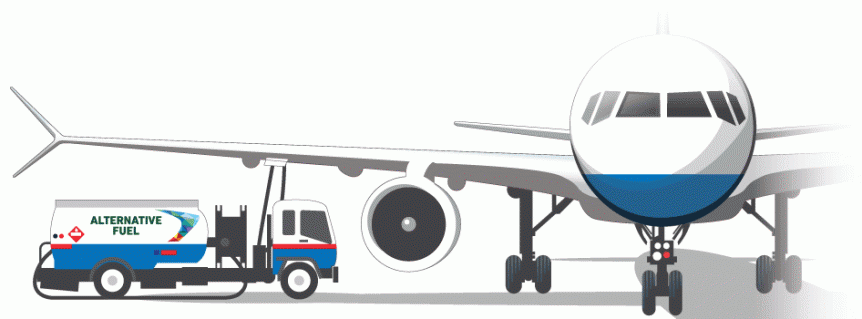Aviation accounts for about two-to-three percent of the total CO2 emitted through burning fossil fuels, according to the Intergovernmental Panel on Climate Change (IPCC). That’s even with military jets flashing their afterburners and trailing un-enhanced high-altitude contrails. Whether these emissions add to global warming or global cooling seems to be still open to debate. Regardless, almost everyone in the industry feels it is worth eliminating the negative aspects of aircraft emissions.
Sea-Tac’s Big Plan
Seattle-Tacoma International Airport, Alaska Airlines and Boeing are partnering to power all flights from Sea-Tac with “sustainable aviation biofuel.” The trio has crafted a long-term roadmap to devise an infrastructure “in a cost-effective, efficient manner.” There may be benefits to the local economy, as well as to operational costs for airlines.
According to Biomass Magazine, “At the Sea-Tac fuel farm Dec. 16, executives for the port, Alaska Airlines, and Boeing signed a memorandum of understanding (MOU) to launch a $250,000 Biofuel Infrastructure Feasibility Study that will assess costs and infrastructure necessary to deliver a blend of aviation biofuel and conventional jet fuel to aircraft at Sea-Tac, a crucial step toward routine biofuel use in the future.”
Port of Seattle Commissioner John Creighton sees a biofuel infrastructure as “an attractive option for any airline committing to use biofuel,” which will assist in “attracting biofuel producers to the region as part of a longer-term market development strategy.”
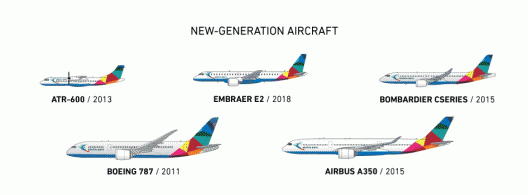
Improved airliners will cut fuel use. Illustration: Aviation: Benefits Without Borders
Moving from fossil-based to the newer technology will be require “significant quantities of biofuel” to serve Sea-Tac’s 26 airlines and more than 380,000 flights annually. The 13th busiest airport in the U. S. will serve over 42 million domestic and international passengers this year.
Joe Sprague, senior vice president of communications and external relations for Alaska Airlines, says, “Biofuel offers the greatest way to further reduce our emissions. This study is a critical step in advancing our environmental goals and stimulating aviation biofuel production in the Pacific Northwest.”
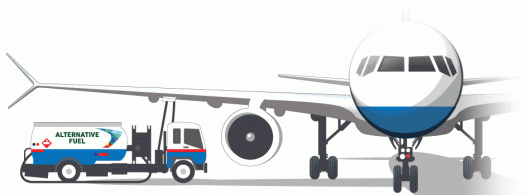
Alternative fuels will reduce emissions from those for fossil fuels. Illustration: Aviation : Benefits Without Borders
The Port of Seattle will manage the study, to be completed by late 2016, and the eventual engineering and integration of the new infrastructure. Currently, all biofuels are imported and have to be transported to the Port by truck, rail or barge.
Sheila Remes, Boeing Commercial Airplanes vice president of strategy, says, “Sustainable aviation biofuel will play a critical role in reducing aviation’s carbon emissions over the long term,” a looks forward to powering every airplane at Sea-Tac with a biofuel blend, “and lead the way for other airports to do the same.”
The “blend” part of the equation is important, since combining the biofuel with regular petroleum-based jet fuel allows use without changes to the aircraft or engines. Using such fuels reduces lifecycle CO2 emissions by 50 to 80 percent compared to conventional petroleum fuel, according to the U.S. Department of Energy. In the last four years airlines have made over 2,000 passenger flights with such blends.
The Port’s Century Agenda Goal is to reduce aircraft-related carbon emissions at Sea-Tac Airport by 25 percent by 2037. The key strategy to reduce these emissions is through aviation biofuel. Historically, the Port has been a leader in supporting research and development of aviation.
Alaska Airlines was the first airline to make multiple flights using a 20-percent blend of biofuel made from cooking oil and waste animal fat.
In 2016, Alaska and Gevo, Inc. will fly the first ever commercial trip on alcohol-to-jet fuel, followed by demonstration flights using fuel made from forest-industry waste developed by the Northwest Advanced Renewable Alliance with that effort led by Washington State University. Fuel for both demonstration flights must first be independently certified. Boeing has already partnered on projects in the U.S., Australia, Brazil, Canada, China, Europe, Japan, the Middle East, South Africa and Southeast Asia.
Getting Better While Getting Bigger
Aviation, from what Aviation: Benefits Beyond Borders, explains, provides a lifeline to many areas of the world that would be neglected without it, from bringing tourists to the otherwise barely accessible Cape Verde Islands to flying organs for transplants into remote areas of Brazil. This expanding use of aircraft is not increasing pollution in these areas, because, according to the organization, “Despite growth in passenger numbers at an average of 5% each year, aviation has managed to decouple its emissions growth to around 3%.” They attribute this to improved aircraft technology and new operating procedures.
An October, 2006 report by Sir Nicholas Stern, former chief economist of the World Bank, explains that power generation contributes about 24 percent of the human-induced CO2 to the world’s total emissions, with 18 percent coming from land use change (forests being cleared, farms turned to factories), “then agriculture, industry and transport at 14% each (aviation is part of transport). Buildings (8%), other energy related activities (5%) and waste (3%) make up the rest.”
Lord Stern’s report goes on. “CO2 is not the only greenhouse gas emitted by aircraft, however. The exhaust from aircraft engines is made up of: 7% to 8% CO2 and water vapor; around 0.03% nitrogen oxides, unburned hydrocarbons, carbon monoxide and Sulphur oxides; traces of hydroxyl family and nitrogen compounds and small amounts of soot particles (although the industry has managed to more or less eliminate soot emissions over the past few decades). Between 91.5% and 92.5% of aircraft engine exhaust is normal atmospheric oxygen and nitrogen.”
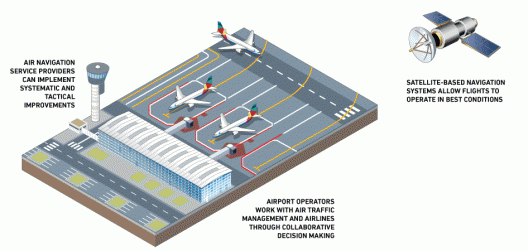
Infrastructure changes will enhance the economies of flight operations. Illustration: Aviation: Benefits Without Borders
Water vapor trails (contrails) are controversial, even pointed to as part of a global geo-engineering conspiracy, although players and motives would be difficult to identify, especially in light of efforts to rid the skies of even the non-conspiratorial traces of a plane’s passage.
Counting vapor trails and nitrogen oxide releases, some recent research suggests that aviation CO2 emissions should be multiplied by 1.9 times to take account of the added impact of these other gasses at altitude. Other transportation emissions sources such as cars, trains and ships can share this same “forcing” multiplier – shipping often being particularly “dirty” because of its use of bunker oil. Some experts say aviation should not be tarred with these multipliers when such additional emissions are not counted in assessing pollution from other transportation sources. Perhaps a more equitable and honest approach would be to include all such emissions to get a better picture of the true environmental impact all our means of transport produce.
Aviationbenefits.org makes the following statement and includes links to important findings and proposals.
The aviation industry is doing a great deal to limit its environmental impact
Read more about how we are addressing the issue of climate change through our climate plan; the technology being deployed to reduce emissions; the search for sustainable sources of energy; improvements to operations that are helping to reduce emissions, delays and noise; infrastructure innovation and the important role economic measures will play in allowing aviation to undertake its climate plan.
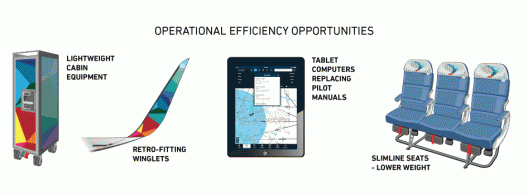
Design and materials changes will aid in making flight more economical and “cleaner”. Illustration: Aviation: Benefits Without Borders
Sea-Tac, Boeing and Alaska Airlines are certainly promoting the clean, green aspects of aviation, as are a great many others in the industry. Let us hope other industries apply as honest a view and as earnest an effort on reducing their emissions.

